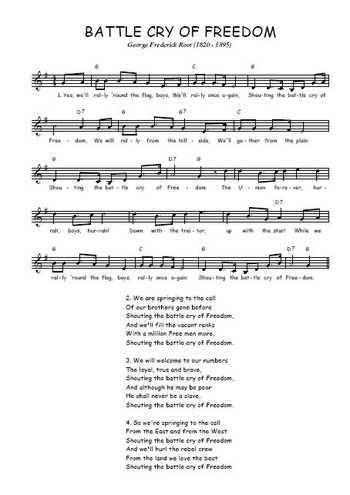
This was Beethoven recalibrated - not the glowering Titan that we see in paintings, but a composer capable of fun and frolic, even frivolity.
Battle cry of freedom violin full#
The Rondo finale was breezy and full of positivity. Phrased with disarming simplicity, it had an ethereality more sensual than philosophical, both in the delicate orchestral accompaniment and in Copes’ gossamer-light, pellucid playing. The Larghetto middle movement was particularly affecting. Light of touch and chirruping, his solo lines frequently floated birdlike over the orchestral textures, liberated from the cut and thrust of terrestrial activity. In this congenial environment, Copes emerged organically as a soloist of refined sensibility and emotional intelligence. Rhythms were springier, and a sense of fresh air breathed throughout the orchestra. The differences in outcome were stark, and positive. Thirty-three musicians accompanied Copes, about half the number typically used in Beethoven’s concerto by a full-sized symphony orchestra. The soloist was Steven Copes, who this year celebrates his 20th anniversary as the SPCO’s concertmaster. The performance of Beethoven’s Violin Concerto had similar qualities of joy and elation. SPCO breathes life into Beethoven, debuts 'Records from a Vanishing City' Yes, it’s wonderful when audience are treated to guest players from elsewhere, but the SPCO musicians themselves have the capacity to deliver a resounding concert from its core group. The concert was a testament to the talent held at the SPCO. There are also moments of synchronicity, such as a section where Julie Albers on the cello and Copes share the melody.

There are lovely moments of harmony amongst the soloists, with oboist Cassie Pilgrim and bassoon player Fei Xie sounding particularly beautiful together. It’s a chamber piece within a chamber piece, as four soloists perform in contrast with the rest of the orchestra. The second piece on the program is Haydn’s Sinfonia concertante. Prokofiev once called those scales “wind passing through a graveyard.” Indeed they sound like a spirit released from the earthly world. The scales that were heard in the first movement come back, now sounding as if they are very far away. The fourth movement is a fierce dance that surprises in its haunting ending. Then in the third movement the xylophone creates a dreamlike sound. The second movement is harsher, as Copes strikes the strings in fury. The music makes your breath stop with its lilting scales that sound like waves. It continues as a rich tapestry of sounds, with overlapping phrases. The piece begins with the bass players taking on the creeping low notes, which the violin responds to with ominous trills. Two of the movements were played at Prokofiev’s funeral, after the composer died the same day as Stalin.Ĭopes, wearing a ribbon with Ukraine’s colors, soars in his playing, and seems almost buoyed by the new arrangement played by his fellow musicians. The work holds the weight of those events within it, and ghosts speak through it. Prokofiev didn’t complete the sonata until after the end of World War II, in 1946. That was at the time Stalin embarked on his “great purge” where he killed hundreds of thousands of his enemies and sent millions more to forced labor camps. Prokofiev began writing the piece two years after he returned to the Soviet Union after living abroad, in 1938. He urged audience members to search up the original. Speaking before the world premiere Friday evening, Prutsman said it took over a year to make the arrangement, but that work in no way compared to the genius of Prokofiev himself. 1, with the orchestra taking on the piano part. Stephen Prutsman, an artistic partner with the orchestra from 2004-2007, was commissioned to arrange Prokofiev’s Violin Sonata #1, originally composed for violin and piano, as Sonata for Violin and Orchestra, No. The SPCO still requires masks at venues that are not the Ordway, which happens on Sunday when the performance takes place at Ted Mann Concert Hall.

With capacity capped at 50 percent, around a third of the audience seemed to not be wearing masks.

Edited by Mark Geslison.Friday’s performance at the Ordway Concert Hall marked a new chapter in the ongoing shifting landscape of the pandemic: masks were no longer required, and the venue no longer checks vaccine cards.

Includes access to online audio, recorded by full band. Many have a harmony part to match the melody. All tunes contain a simple melody, and most contain an intermediate or advanced part. A collection of Bluegrass, Old Time and Celtic tunes, including hoedowns, waltzes, reels, rags, hornpipes, jigs, polkas, and airs.


 0 kommentar(er)
0 kommentar(er)
